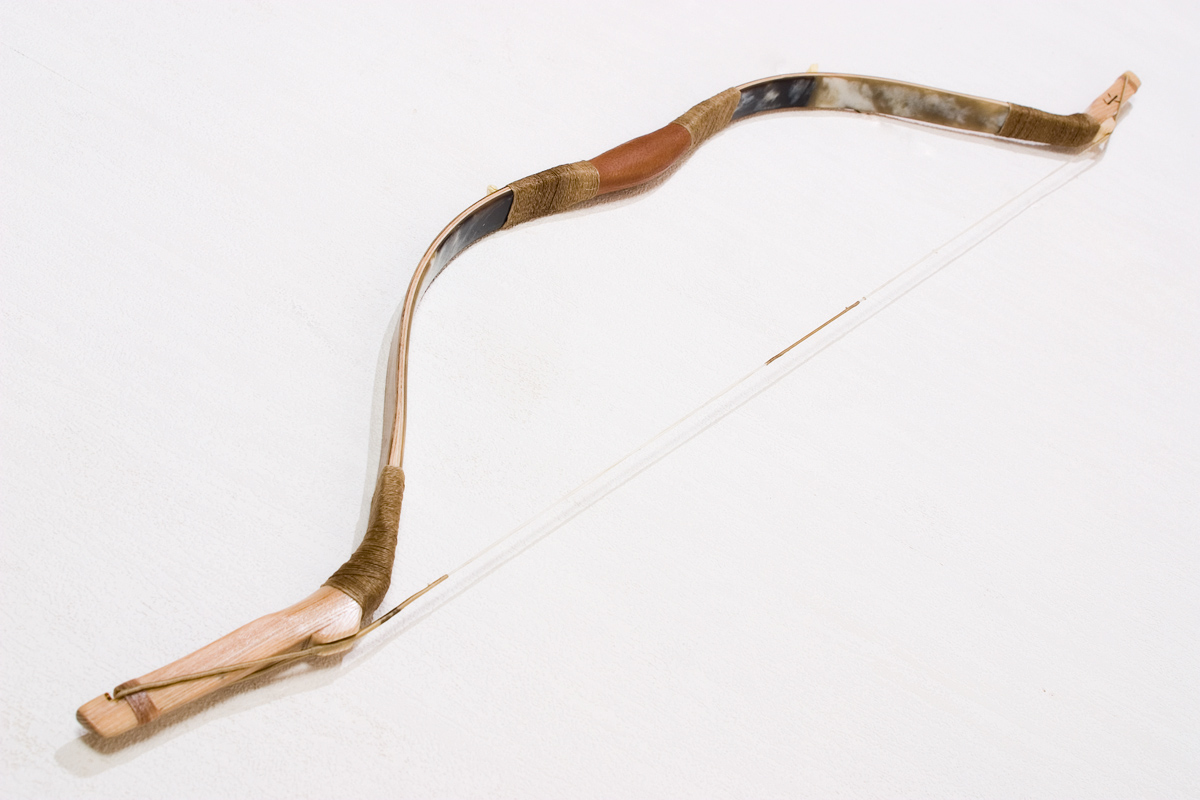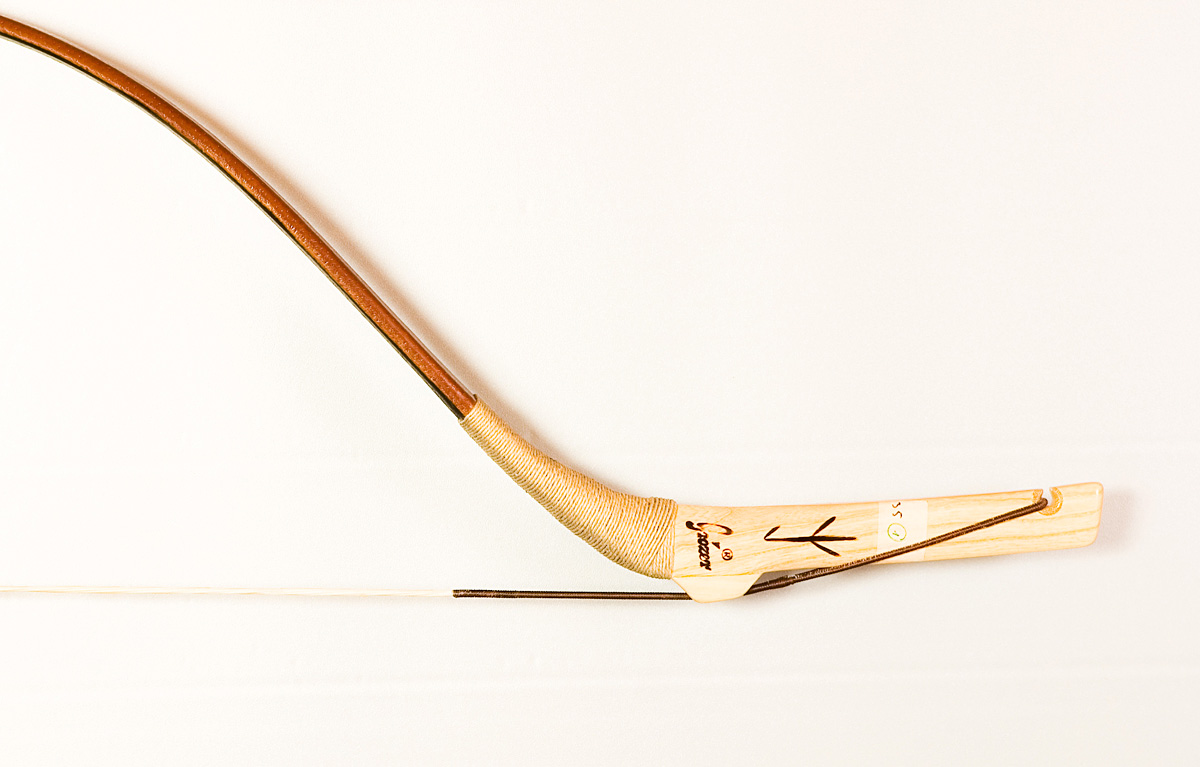History of the recurve bow
 The use of the bow and arrow goes back into the paleolithic. There is evidence of bows and arrows in use Between 8,000 and 9,000 BC in Schleswig Holstein (northern Germany). Elm and yew seems to have been favoured woods for bowmaking, while arrows were made of hazel. The arrowheads were made of flint and were fastened to the arrow shaft with pine resin and sinews of nettle stems. The pine resin was heated with charcoal to produce a flexible glue of great strength. Ötzi the Iceman found in the Alps carried an unfinished bow made of Yew when he died in the neolithic period. His bowstring was of flax, but we believe sinew (from deer legs) was also used. A major technological advance of the late neolithic was the use of sapwood on the bowface for increased flexibility. This allowed the bows to be pulled with far greater force without breaking. This in turn allowed hunters much greater range and accuracy.
The use of the bow and arrow goes back into the paleolithic. There is evidence of bows and arrows in use Between 8,000 and 9,000 BC in Schleswig Holstein (northern Germany). Elm and yew seems to have been favoured woods for bowmaking, while arrows were made of hazel. The arrowheads were made of flint and were fastened to the arrow shaft with pine resin and sinews of nettle stems. The pine resin was heated with charcoal to produce a flexible glue of great strength. Ötzi the Iceman found in the Alps carried an unfinished bow made of Yew when he died in the neolithic period. His bowstring was of flax, but we believe sinew (from deer legs) was also used. A major technological advance of the late neolithic was the use of sapwood on the bowface for increased flexibility. This allowed the bows to be pulled with far greater force without breaking. This in turn allowed hunters much greater range and accuracy.
The arrival of metal working meant not only metal arrowheads, but also metal blades, axes drawscapers and so on for making bows. This meant they could be made far more quickly and accurately than ever before. You can always find a mention of archery in literature, art, Greek mythology, language, warfare, Humanities, and much more. The bow was such a pivotal device back in the past, that many historians consider it almost as important as the wheel and fire.
Simply stated, the bow is a stringed projectile weapon designed to shoot arrows. It consists of a slender stave (the bow-stick) and a cord fastened to it at each end under a certain amount of tension. By drawing the string and the arrow back until the stave is bent, and then releasing the string, the impelling force of the bowstring shoots the arrow5. Though it sounds easy, many bows require as much as hundreds of pounds of force to bend the bow sufficiently and then incredible marksmanship to make the arrow fly true.
Bows are of two basic kinds: wooden and composite. The earliest bows were undoubtedly made from wood, probably simply cut from saplings and whittled into the desired shape and strung with animal gut. These earliest of bows developed into the short bow, longbow, and various other plain bows.
The mongolian style is a more than 1000 year-old-style. The mongolian bows are always symmetric bows. Their speciality is, that they have „string-pads” for stopping the string rapidly after the shot. It’s aim is that, that the arrow earns a higher impulse, and a higher starting velocity than at the other bows, which have no string-pads.



 At the dawning of the 10th Century CE, the Khitai, a cattle- and horse-keeping nation who lived in South-East Mongolia, took over the eastern territories of the steppes, and not long after they conquered Eastern China as well. The ruling class of the Khitai, reigning in this part of China from 907 to 1125, was known as the Liao Dynasty. Their dominion was defeated by a subject south Manchurian tribal alliance, called the Dzsürcsi (?).
At the dawning of the 10th Century CE, the Khitai, a cattle- and horse-keeping nation who lived in South-East Mongolia, took over the eastern territories of the steppes, and not long after they conquered Eastern China as well. The ruling class of the Khitai, reigning in this part of China from 907 to 1125, was known as the Liao Dynasty. Their dominion was defeated by a subject south Manchurian tribal alliance, called the Dzsürcsi (?).








 The use of the bow and arrow goes back into the paleolithic. There is evidence of bows and arrows in use Between 8,000 and 9,000 BC in Schleswig Holstein (northern Germany). Elm and yew seems to have been favoured woods for bowmaking, while arrows were made of hazel. The arrowheads were made of flint and were fastened to the arrow shaft with pine resin and sinews of nettle stems. The pine resin was heated with charcoal to produce a flexible glue of great strength. Ötzi the Iceman found in the Alps carried an unfinished bow made of Yew when he died in the neolithic period. His bowstring was of flax, but we believe sinew (from deer legs) was also used. A major technological advance of the late neolithic was the use of sapwood on the bowface for increased flexibility. This allowed the bows to be pulled with far greater force without breaking. This in turn allowed hunters much greater range and accuracy.
The use of the bow and arrow goes back into the paleolithic. There is evidence of bows and arrows in use Between 8,000 and 9,000 BC in Schleswig Holstein (northern Germany). Elm and yew seems to have been favoured woods for bowmaking, while arrows were made of hazel. The arrowheads were made of flint and were fastened to the arrow shaft with pine resin and sinews of nettle stems. The pine resin was heated with charcoal to produce a flexible glue of great strength. Ötzi the Iceman found in the Alps carried an unfinished bow made of Yew when he died in the neolithic period. His bowstring was of flax, but we believe sinew (from deer legs) was also used. A major technological advance of the late neolithic was the use of sapwood on the bowface for increased flexibility. This allowed the bows to be pulled with far greater force without breaking. This in turn allowed hunters much greater range and accuracy.
 Temüjin, widely known today as Gengis Kahn, was born in 1162 near the river Onon, Asia. He as the great Mongolian leader who forged the clans living north of the Gobi desert into one strong alliance. These clans had for long fought for dominance of the area. Gengis’s warriors fought their way through the vast steppes and established an empire unprecedented before. Legend has it that the great leade Gengis was born under a lucky star and he will once again come and lead the Mongolians to glory.
Temüjin, widely known today as Gengis Kahn, was born in 1162 near the river Onon, Asia. He as the great Mongolian leader who forged the clans living north of the Gobi desert into one strong alliance. These clans had for long fought for dominance of the area. Gengis’s warriors fought their way through the vast steppes and established an empire unprecedented before. Legend has it that the great leade Gengis was born under a lucky star and he will once again come and lead the Mongolians to glory.  The empire that Gengis, his numerous (he probably had as many as 1200 children) sons and innumerable grandsons established, was surpassed only by the British Empire in the 19th century. The Mongolian Empire ranged from the Yellow Sea to the Meditarrenean in 1280. The too quick rise of the empire led to a quick fall too, it has fallen into smaller kingdoms, although the Golden Horde lasted as long as 1502 in today’s Russia.
The empire that Gengis, his numerous (he probably had as many as 1200 children) sons and innumerable grandsons established, was surpassed only by the British Empire in the 19th century. The Mongolian Empire ranged from the Yellow Sea to the Meditarrenean in 1280. The too quick rise of the empire led to a quick fall too, it has fallen into smaller kingdoms, although the Golden Horde lasted as long as 1502 in today’s Russia.